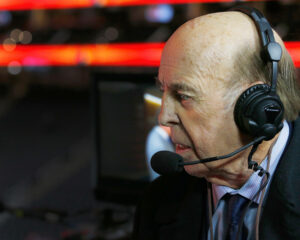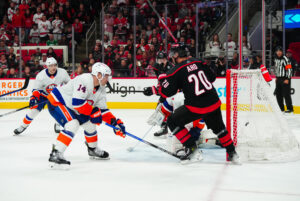Now that the smoke has settled on the Sens free agency, how will Vladimir Tarasenko fit in the lineup? Adding a player of Tarasenko’s pedigree can only be positive for a forward group. Here we shall explore some thoughts and numbers behind how well he will fit. One thing is for sure, the Senators and Tarasenko are sure glad to be together.
Tarasenko Is a part of the Ottawa Senators, What’s Next?
The signing of Tarasenko with the Ottawa Senators to a $5M contract is big news. With this addition, it brings depth and experience to the forward group. Anytime you can add a Stanley Cup winner, much less a six-time 30-goal scorer, you’re improving your standing. However, this money has brought some difficulty in the team staying under the cap. So, it is possible the current roster must shuffle a bit. With that said, the top-nine forwards, where Tarasenko impacts, should be fairly similar. Thus we can do our analysis based on what this means for the top-three forward lines.
Other Necessary Roster Moves and Potential Call-Ups
Since we are focusing on the top three forward lines specifically, and the Sens need to be cap compliant, we will make a couple of assumptions. To sign Shane Pinto to his 10.2 (c) (RFA) contract, they need to free up some money. Therefore, it is likely they need to move Mathieu Joseph’s contract. Furthermore, it looks like some of the Senators prospects will get a chance in 2023-24. Earlier in the offseason, General Manager Pierre Dorion hinted that several players would get a chance. Those young forwards include Ridly Greig, Angus Crookshank, Roby Jarventie, Egor Sokolov, and Cole Reinhardt. Based on his play with the Belleville Senators last year and his subsequent call-up to the NHL, Greig is a frontrunner.
Top Three Line Combinations
Now that we have all the ideas of who makes the lineup, let’s come up with a lineup projection. So, we can include Pinto, Greig, and newly acquired Dominik Kubalik in the top nine. Hence, a shot at what the top three forward lines look like is as follows:
Tkachuk – Stutzle – Giroux
Tarasenko – Norris – Batherson
Kubalik – Pinto – Greig
From a high level, this alignment seems to make the most sense. The top line was too successful last year, not to stick with it. According to Moneypuck.com they ended up with an xGOALS% of 59.9 and combined for 90 + 83 + 79 = 252 points. Next, for the second line, the Norris-Batherson combination has seen too much past chemistry and success. When you add the team’s next best available forward, who had a career-high 82 points just back in 2021-22, seems like a winning recipe. Finally, the third line falls into place nicely as well. You have a hard-nosed, straight-line player in Kubalik, who mixes in scoring touch. Pinto is coming into only his second full professional season, after 20 goals in his rookie campaign. Then you throw in Greig, but really it is whatever young player is playing best. They will be playing hard, contributing, and accountable, or they won’t be on the third line of the big club.
Tarasenko Finding a Home
From a logistical standpoint, it appears putting Tarasenko on the second line works. So the natural question becomes, how can we conclude that? First of all, Norris and Batherson have played together a lot, and rightfully so given their chemistry. As a top line with Tkachuk, Norris had 35 goals in 66 games in 2021-22. Meanwhile, Batherson was nearly a point a game with 44 points in 46 games played. Playing as a second line should make for easier matchups. Meshing with Tarasenko should come easy for these Ottawa Senators, as he is such a talent. He can stickhandle in a phone booth, still has a wicked wrist shot, and is motivated. This line would exhibit some size, and a lot of skill, and will be a feared matchup for any team as a second line.
The Power Play Theory Debate
The more challenging place to find a successful configuration would be on the power play. This was a bit of a problem last year, and that was with Norris out all year. They have such an overabundance of skilled, offensive forces, Coach D.J. Smith needs to find two units and stick with it. In contrast, there is the theory in today’s game you can ride your top unit, and give them extra time. Two great examples include the Edmonton Oilers (1st at 32.36%) or the Toronto Maple Leafs (2nd at 26.02). They load up their top unit, give them extra opportunities, and that top unit is very productive.
Even though loading up the top unit is a formula for regular season success, there might be another answer. The Seattle Kraken for instance, has 10 players score between 3 and 7 power play markers in 2022-23. They did not have a tonne of power play success, but what it did do was generate scoring depth throughout the lineup. The type of depth is imperative for playoff triumph. Fourth-liners like Daniel Sprong got power play time and gained scoring confidence as a result. Jack Eichel and the Stanley Cup Champion Vegas Golden Knights are another example. Eichel was their leading point producer, with 27 goals, but only two, yes two, came via the man advantage. If you utilize the two units with equality, then it is not a blow to a player’s confidence to be on the second unit.
Options for the Senators two power plays with key stats (from 2022-23):
Top Unit
Brady Tkachuk – 97 shots
Tim Stutzle – 28 points
Claude Giroux – 61.6 FOW%
Thomas Chabot – 15 assists
Vladimir Tarasenko – 4.9 Pts/60 min
Second Power Play
Josh Norris – 16 goals (2021-22)
Drake Batherson – 29 points
Jakob Chychrun – CF% Rel of 2.9
Dominik Kubalik – 5.2 Pts/60 min
Shane Pinto – 1.8 G/60 min
Jake Sanderson – 5.3 Pts/60 min
Main Photo: Charles LeClaire-USA TODAY Sports






